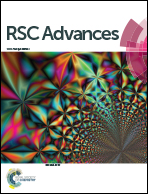Nearly warm white-light emission of silicon-rich amorphous silicon carbide
Abstract
Nearly warm white-light photoluminescence of silicon-rich amorphous silicon carbide (Si-rich a-SixC1−x) films grown by middle-temperature plasma-enhanced chemical vapor deposition is demonstrated. The argon diluted silane, methylsilane and methane environment and low RF plasma power regime assist the achievement of extremely low oxygen incorporation and relatively high tenability of the composition ratio x. From XPS analysis, the decomposed Si2p orbital electron related energy distribution reveals plentiful Si–Si bonds, gradually reduced Si–C bonds and suppressed Si–O and C–Si–O bonds at a deposition temperature of 650 °C. The Si nanocrystals (Si-ncs) with estimated grain sizes of 2.9 ± 0.3 nm contribute to structural and optical properties. Moreover, the Si–C stretching mode is slightly red-shifted from 806 to 785 cm−1 with increasing deposition temperatures from 450 °C to 650 °C, and the reduced strength and quantity of the Si–C bonds are also observed. The luminescent a-SixC1−x film can only be obtained when deposition occurs at 650 °C since the middle-temperature synthesis induces fractional precipitation of Si-ncs. The post-annealing at 1100 °C for 90 minutes is optimized to re-grow the Si-rich SixC1−x matrix, which leads to the crystallization of SixC1−x with self-aggregated Si-ncs. Such annealed a-SixC1−x films with warm white-light photoluminescence can serve as potential solid-state phosphorous materials for future white-light light-emitting applications.


 Please wait while we load your content...
Please wait while we load your content...